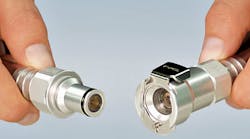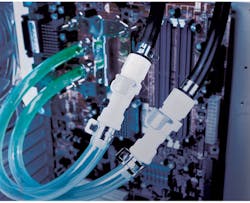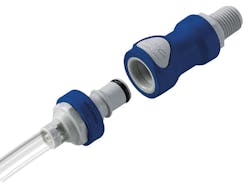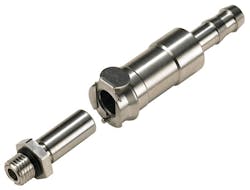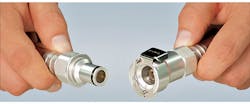Download this article in .PDF format
Implementing an efficient, effective, and safe cooling system to remove waste heat from servers is an ever-growing concern when designing data center infrastructure. In most data center installations, large air conditioning systems and massive amounts of circulating air are used to remove the heat.
However, using chilled air to cool servers is costly and inefficient. In many cases, electricity represents a data center’s largest operating expense (Fig. 1). What’s more, as computer servers are pushed to run faster and as data center rack densities increase, it is becoming impractical to expect moving air to provide sufficient cooling.
As a result, server manufacturers are turning to liquid cooling systems to more efficiently remove heat (Fig. 2). This idea is not new. The first supercomputers of the mid-1960s used liquid cooling to keep them from self-destructing. As computers became more efficient and produced less waste heat, air cooling became more practical.
Today’s microprocessing chips are smaller and more powerful than ever, though, producing more heat. As CPU clock speeds and rack power densities increase, manufacturers are once again turning to liquid cooling to remove the excess heat. In addition, since a water-based circulating liquid is up to 30 times more efficient at removing heat than a moving airstream, liquid cooling cuts operating costs significantly.
While still an evolving technology, today’s liquid-cooling applications are being scaled for data center operations and modularized to permit maintenance that is as easy and uncomplicated as air-cooled systems and permits change-out of servers without drips, leaks, or spills.
A typical liquid-cooling system for a server consists of a plate-style heat exchanger mounted directly on the server microprocessor, CPU, or other concentrated area of heat. The heat exchanger efficiently transfers the heat from the CPU to the circulating liquid, usually a water-glycol mixture. Cool or sometimes room-temperature liquid is supplied to the plate-style heat exchanger, and the warmed liquid is then transported away via flexible tubing. The warm liquid is eventually routed to a central liquid-to-air or liquid-to-liquid heat exchanger that may or may not involve a chiller system.
A Critical Component
A critical component in these liquid-cooling systems is the quick disconnect coupling. These couplings connect the flexible tubes that carry the cooling liquid to each individual server and back out to a central manifold on the server rack that is ultimately connected to the central liquid-to-air or liquid-to-liquid heat exchanger (Fig. 3). When servers need to be serviced or changed out, the couplings must easily disconnect without dripping or spilling coolant on sensitive electronics.
When selecting quick disconnect couplings for liquid cooling of servers and other high-end computers, it is important to look for seven design and performance attributes to ensure reliability, convenience, and affordability.
1. Reliability
The chief concern of server designers and data center operators is system reliability. One of the basic methods of achieving high reliability is through redundant components that take over if primary components fail. In liquid-cooling systems, redundant pumps are often used to prevent loss of circulation.
However, individual quick disconnect couplings in the cooling system represent a single point of failure. If a coupling fails, there is no automatic backup supply of cooling liquid. Also, a leak might cause the entire server rack to fail. This puts a laser-like focus on the design, construction, and quality of the quick disconnect coupling.
While temperatures and pressures used in liquid-cooling systems are fairly low, any coupling—plastic or metal—needs to be reliable enough to connect securely and remain secure for months or years at a time and then to disconnect easily without drips or spills.
Some liquid-cooling systems employ couplings developed for the hydraulics industry because of their perceived higher durability. However, the seals and internal valves of these couplings were not designed for low pressure or applications where they are required to be connected for months or years at a time. When selecting quick disconnect couplings for liquid-cooling systems, look for couplings that:
• Are designed specifically for low-pressure applications
• Feature quality construction
• Offer simple and sure locking mechanisms (either push-to-connect or quarter-twist types)
• Are made of durable materials and have O-rings and internal valves that are compatible with the cooling media.
2. Ruggedness
Resistance to physical shock and overall durability are also important traits in liquid-cooling system quick disconnect couplings. While these couplings are not connected and disconnected frequently, system designers often have been reluctant to use plastic couplings because they believe metal couplings are more rugged.
In real-world applications, today’s quick disconnect couplings made from engineered polymers offer more than sufficient strength and durability in low-pressure, moderate-temperature applications such as liquid cooling for electronics (Fig. 4). While either metal or plastic couplings can be employed successfully, there can be significant cost differences between the two materials.
3. Ease Of Use
Data center operators want to be able to easily disconnect the cooling loops from servers with no spills. Whether it is a push-to-connect or twist-lock type of coupling, the valves need to reliably close when disconnected, even after having been connected for months or years. In addition, plastic couplings can be molded with softer and more ergonomic gripping surfaces that are easier to grip than metal couplings.
When a cooling system is equipped with properly designed quick disconnect couplings, it simplifies maintenance and serviceability. Technicians used to connecting and disconnecting Ethernet connections and power cables will have little trouble with intuitively designed quick disconnect couplings.
4. “Dry Disconnect” Capability
Quick disconnect non-spill couplings can feature two styles of internal valves that automatically shut off the flow of liquid when the couplings are disconnected. One style, called a double-shutoff coupling, features poppet valves that, by virtue of their design, trap a small amount of liquid within the coupling body. This liquid can drip out when the coupling is disconnected. While the leakage is not a large amount, likely just a drop or two, it might be sufficient to raise safety or reliability concerns around electronics.
In contrast, true dry-disconnect couplings feature flush-face valves that allow no more than a coating of cooling fluid on the valve surfaces, virtually eliminating the possibility of dripping onto vital components (Fig. 5). Look for couplings that feature precision-made, internal flush-face valves. Material selection and manufacturing quality play a big part in ensuring that an internal valve will close automatically and securely upon disconnection, even after having been held open for months or years in operation.
5. Resilient Seals
As previously noted, couplings used in liquid-cooling applications have to stay connected for a long time and then still function perfectly upon disconnection and reconnection so there are no coolant drips or leaks. Seals that are not properly formulated or designed can take a “set” that causes leaks upon disconnection. The seals also have to be compatible with the cooling liquid so they don’t swell, shrink, or otherwise become distorted. In some cases, couplings may feature dual seals to enhance sealing capabilities in the quest for higher reliability. However, dual seals can introduce greater friction in the system, and they might reduce reliability if not designed properly.
6. Materials Compatibility
Most plastics and metals are compatible with cooling liquids such as water-glycol mixtures. But if your cooling system uses a proprietary cooling liquid, be sure to determine whether it will be compatible with the coupling housings, seals, valves, and tubing. Use particular caution when selecting metal couplings for the cooling system that might come into contact with a server chassis, as dissimilar metals can create electrolysis and corrosion where they touch (Fig. 6).
7. Affordability
There is little difference in real-world performance between engineered polymer and metal quick disconnect couplings, but there is a significant cost difference. And when you consider the thousands of couplings used in data center liquid-cooling systems, even small price differences add up.
Couplings developed from metal ball-and-sleeve hydraulic couplings are not properly intended to be used for cooling applications and can lead to unnecessary expenditures. But when metal quick disconnect couplings are preferred, look to a supplier that offers a variety of metal couplings that were specifically designed for cooling applications.
Conclusion
Liquid cooling of computers and servers is becoming more attractive today as computer chips run faster, data centers increase rack densities, and the cost of cooling with air continues to escalate. With cooling system designs still evolving, it is important to understand the role that quick disconnect couplings play in these systems and how they contribute to computer serviceability, operator convenience, and overall performance.
Evaluating couplings based on the seven attributes of reliability, ruggedness, ease of use, non-spill capability, seal functionality, media compatibility, and affordability brings assurance of long-term performance. Working with a coupling supplier that can offer a wide selection of plastic and metal couplings, along with custom design capabilities, will ensure the best choice for your application.
Dennis Downs is the specialty industrial business unit manager at Colder Products Company in St. Paul, Minn. He leads the development of product and marketing strategies for industrial market segments including liquid cooling, printing and ink management, engine systems, and chemical handling. For more than 15 years, he has served Colder in a variety of capacities including product development, customer solutions, strategic market development, and creation of new technologies. He holds a BS in mechanical engineering from the University of Wisconsin – Madison and an MBA from the University of St. Thomas in St. Paul, Minn.
